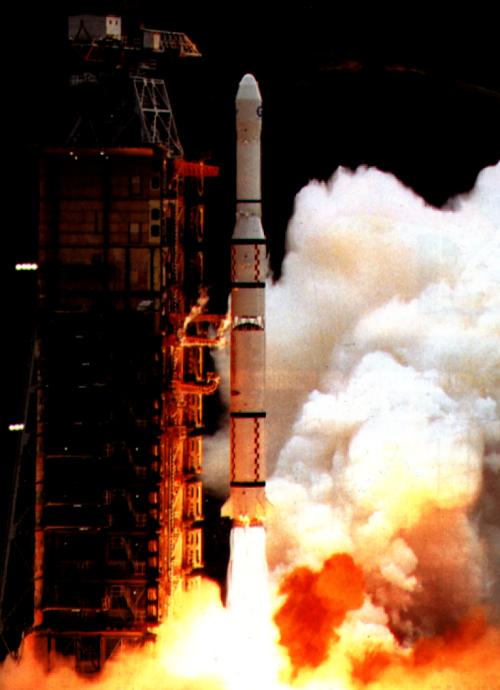
Long March 3
In-activeChina Aerospace Science and Technology Corporation (CASC)
Jan. 29, 1984
Description
The Long March 3 is a chinese orbital carrier rocket. They all launched from Launch Area 3 at the Xichang Satellite Launch Center. It is a 3 stage rocket used to put communication satellites into geosynchronous trasfer orbits.
Specifications
-
Stages
3 -
Length
23.49 m -
Diameter
3.35 m -
Fairing Diameter
3.35 m -
Launch Mass
204.0 T -
Thrust
2961.0 kN
Family
-
Name
Long March 3 -
Family
― -
Variant
― -
Alias
― -
Full Name
Long March 3
Payload Capacity
-
Launch Cost
― -
Low Earth Orbit
5000.0 kg -
Geostationary Transfer
Orbit
1500.0 kg -
Direct Geostationary
― -
Sun-Synchronous Capacity
―
China Aerospace Science and Technology Corporation
Government
Chairman & President: Lei Fanpei
CASC 1999The China Aerospace Science and Technology Corporation (CASC) is the main contractor for the Chinese space program. It is state-owned and has a number of subordinate entities which design, develop and manufacture a range of spacecraft, launch vehicles, strategic and tactical missile systems, and ground equipment. It was officially established in July 1999 as part of a Chinese government reform drive, having previously been one part of the former China Aerospace Corporation. Various incarnations of the program date back to 1956.
Long March 3 | Feng Yun 2B
China Aerospace Science and Technology Corporation | ChinaXichang Satellite Launch Center, People's Republic of China
June 25, 2000, 11:50 a.m.
Long March 3 | Feng Yun 2A
China Aerospace Science and Technology Corporation | ChinaXichang Satellite Launch Center, People's Republic of China
June 10, 1997, 12:01 p.m.
Long March 3 | Zhongxing 7
China Aerospace Science and Technology Corporation | ChinaXichang Satellite Launch Center, People's Republic of China
Aug. 18, 1996, 10:27 a.m.
Status: Launch Failure
Mission:
ChinaSat 7 or ZX 7 (Zhongxing 7) is a Hughes HS-376 model geostationary telecommunications satellite built for the China Telecommunications Broadcast Satellite Corporation (ChinaSat). It was the first satellite ChinaSat had ordered from a western spacecraft contractor, Hughes Space and Communications International, Inc., known today as Boeing Satellite Systems International, Inc.
Geostationary OrbitLong March 3 | Apstar 1A
China Aerospace Science and Technology Corporation | ChinaXichang Satellite Launch Center, People's Republic of China
July 3, 1996, 10:47 a.m.
Status: Launch Successful
Mission:
The APSTAR 1 spacecraft carries such general communications traffic as voice, fax, data, and television signals across China and Hong Kong, Indonesia, Japan, Singapore, and Vietnam. APSTAR 1A has expanded coverage to India and Pakistan. Hughes Space and Communications International, Inc., signed a contract in May 1992 with APT Satellite Company, Ltd., of Hong Kong for the first satellite. APT ordered APSTAR IA in March 1995. The spacecraft were built at the Hughes Space and Communications Company facilities in El Segundo, Calif.
Geostationary OrbitLong March 3 | APSTAR 1
China Aerospace Science and Technology Corporation | ChinaXichang Satellite Launch Center, People's Republic of China
July 21, 1994, 10:55 a.m.
Status: Launch Successful
Mission:
The APSTAR 1 spacecraft carries such general communications traffic as voice, fax, data, and television signals across China and Hong Kong, Indonesia, Japan, Singapore, and Vietnam. APSTAR 1A has expanded coverage to India and Pakistan. Hughes Space and Communications International, Inc., signed a contract in May 1992 with APT Satellite Company, Ltd., of Hong Kong for the first satellite. APT ordered APSTAR IA in March 1995. The spacecraft were built at the Hughes Space and Communications Company facilities in El Segundo, Calif.
Geostationary OrbitLong March 3 | DFH-2A 5
China Aerospace Science and Technology Corporation | ChinaXichang Satellite Launch Center, People's Republic of China
Dec. 28, 1991, noon
Long March 3 | Asiasat 1
China Aerospace Science and Technology Corporation | ChinaXichang Satellite Launch Center, People's Republic of China
April 7, 1990, 1:30 p.m.
Long March 3 | DFH-2A 4
China Aerospace Science and Technology Corporation | ChinaXichang Satellite Launch Center, People's Republic of China
Feb. 4, 1990, 12:27 p.m.
Long March 3 | DFH-2A 3
China Aerospace Science and Technology Corporation | ChinaXichang Satellite Launch Center, People's Republic of China
Dec. 22, 1988, 12:40 p.m.
Long March 3 | DFH-2A 2
China Aerospace Science and Technology Corporation | ChinaXichang Satellite Launch Center, People's Republic of China
March 7, 1988, 12:41 p.m.
Long March 3 | DFH-2A 1
China Aerospace Science and Technology Corporation | ChinaXichang Satellite Launch Center, People's Republic of China
Feb. 1, 1986, 12:37 p.m.
Long March 3 | DFH-2 2
China Aerospace Science and Technology Corporation | ChinaXichang Satellite Launch Center, People's Republic of China
April 8, 1984, 11:20 a.m.
Soyuz 2.1a
Obzor-R No.1
43/4 (43R) - Plesetsk Cosmodrome, Russian FederationNote: Assignment of payloads to this launch is uncertain. The Russian Obzor-R satellite is a planned X-band radar earth observation satellite desi…
LVM-3 (GSLV Mk III)
BlueBird Block 2 #1
Satish Dhawan Space Centre Second Launch Pad - Satish Dhawan Space Centre, IndiaAST SpaceMobile’s Block 2 BlueBird satellites are designed to deliver up to 10 times the bandwidth capacity of the BlueBird Block 1 satellites, requi…
Long March 12A
Demo Flight
Long March 12A Pad - Jiuquan Satellite Launch Center, People's Republic of ChinaFirst test launch of CASC/SAST’s Long March 12A rocket, with a dummy payload. The rocket’s 1st stage attempted to land on a landing pad about 300 km …
HANBIT-Nano
Spaceward
HANBIT Pad - Alcântara Space Center, Federative Republic of BrazilMaiden orbital launch attempt for the South Korean start-up Innospace and its HANBIT-Nano small launch vehicle. Onboard this flight are five small sa…
H3-22
Michibiki 5 (QZS-5)
Yoshinobu Launch Complex LP-2 - Tanegashima Space Center, JapanQZSS (Quasi Zenith Satellite System) is a Japanese satellite navigation system operating from inclined, elliptical geosynchronous orbits to achieve o…

